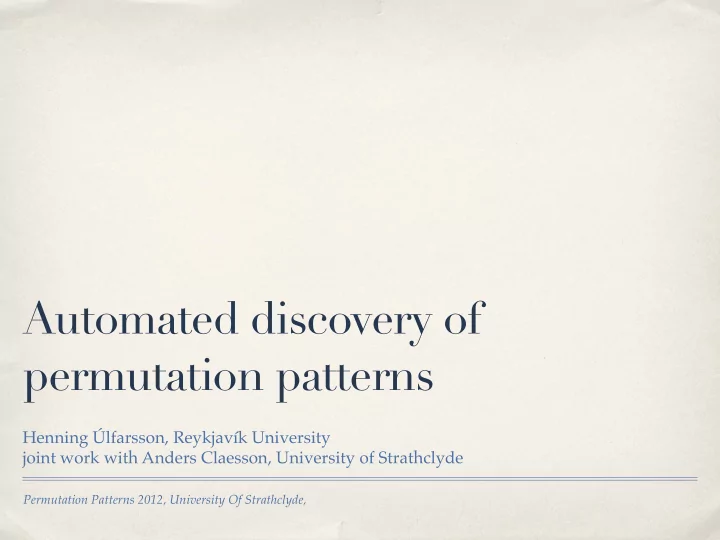

Automated discovery of permutation patterns Henning Úlfarsson, Reykjavík University joint work with Anders Claesson, University of Strathclyde Permutation Patterns 2012, University Of Strathclyde,
Origin of this talk
What do we want to do? ✤ Come up with and prove conjectures such as: A perm is West-2-stack-sortable if and only if it avoids (Proved by West in his thesis, 1990)
There is a nice algorithm... ✤ ... for classical patterns: What patterns does this class avoid? {1, 12,21, 132,213,231,312,321, 1432,2143,2413,2431,3142,3214,3241,3412,3421,4132,4213,4231,4312, ... } ✤ We scan through the list and when we see the first missing perm we add it to the base B = {123} ✤ We keep on scanning and when we see another missing perm we check if it contains something from the base. If not we add it to the base. B = {123,4321}. We keep going and hope the base stops growing ✤ Note that we are using the missing perms to discover the patterns
But not everything is “classical” ✤ Sometimes a set of perms has an infinite or no basis ✤ Mesh patterns to the rescue! (Brändén & Claesson, 2010) ✤ Any set of permutations can be described by mesh patterns
Mesh patterns in permutations ✤ A few mesh patterns inside 513426
An algorithm for mesh patterns ✤ Step 1: Discover the allowed patterns This was the first This is easy - also parallelizes beautifully! implementation - ✤ Step 2: Find forbidden patterns it was slow! This is the hard part. One way is to search through all possibilities The search space will grow like n!*2 (n+1)2 ✤ Step 2’: Generate (in a smart way) the forbidden patterns. For n = 4 this reduces the run-time from 18 hours to 0.18 seconds!
Testing, testing ( sagenb.org ) ✤ Stack-sortable permutations avoid (Knuth ~1960) ✤ West-2-stack-sortable perms avoid (West 1990) ✤ Factorial Schubert varieties correspond to permutations avoiding (Bousquet-Mélou & Butler 2006)
Stack-sortable perms
West-2-stack-sortable perms
Factorial Schubert varieties
You can play with this yourself sagenb.org
How do we generate the forbidden patterns? ✤ Given the allowed patterns from step 1) we generate the minimal forbidden patterns (can’t search through all possibilities: n!*2 (n+1)2 ) ✤ What does that mean? If the following patterns are allowed then step 2’) will generate two forbidden patterns.
Redundancy ✤ We generate the forbidden patterns for each length individually so there is redundancy between different lengths ✤ We only need to remember that the smaller one is forbidden ✤ There is still some redundancy in the output which we have ideas on how to remove (based on the shading lemma, upgrading, minimal permutations, but current implementations are too slow)
New conjectures ✤ As shown above the algorithm can find old theorems ✤ Discovered some new conjectures: Tableaux conjectures! ✤ But first: what is a tableau
Young tableaux ✤ There is a beautiful bijection between permutations and pairs of YT’s, e.g. 581279643 gives us (using Sage!) ✤ The bijection has several nice properties. But it has been hard to connect patterns in permutations to something in the tableaux ✤ Only special cases are known, e.g. separable patterns (Crites, Panova & Warrington 2011) ✤ We have some new conjectures and results
Perms with hook-shaped tableaux As pointed out by Vince Vatter, this actually follows from a paper by Atkinson on skew-merge perms ✤ Theorem (HÚ & Claesson, Atkinson) A perm has hook-shaped tableaux if and only if it avoids
Sketch of proof ✤ If a perm contains the patterns then it is not hook-shaped by a theorem of Crites, Panova & Warrington, 2011 ✤ Assume it contains
Sketch of proof, cont. ✤ We can assume that we have this pattern ✤ So we have either ✤ This will produce a box in the tableaux. ✤ The other mesh pattern is similar
Sketch of proof, cont. ✤ If there is a box in the tableaux, we let c be the element that first creates it, b the element that bumps it, d the element in (2,1) and a the element that bumped d ✤ Then we know that a < b,c,d and b,d < c, and that d appeared first in the perm, and b appeared last
Sketch of proof, cont. ✤ Recall, trying to produce ✤ Now assume b < d (other case is similar). Then we have one of: c c c d d d Dots must b b b increase DONE! DONE! a from red dot a a DONE!
There seems to be more... ✤ If we create a lattice of shapes, it seems to correspond to a lattice of patterns
<--->
How to prove it? ... have some ideas but an algorithm would be better
Negativity results ✤ Some types of permutations are notoriously hard to describe and even to count ✤ Meanders are one example. These are encodings of flowing rivers
And this does NOT Output from algorithm describe meanders of length 4 or more!
Questions? ✤ Input more datasets of permutations, generate more conjectures ✤ Try it for other properties of permutations (instead of patterns) ✤ Try it for other types of data (instead of permutations) (Can it discover Kuratowski’s thm for graphs?) ✤ Can it be made into a theorem prover, instead of just conjecturer? Have another algorithm that can prove special cases (also joint with Anders)
Recommend
More recommend